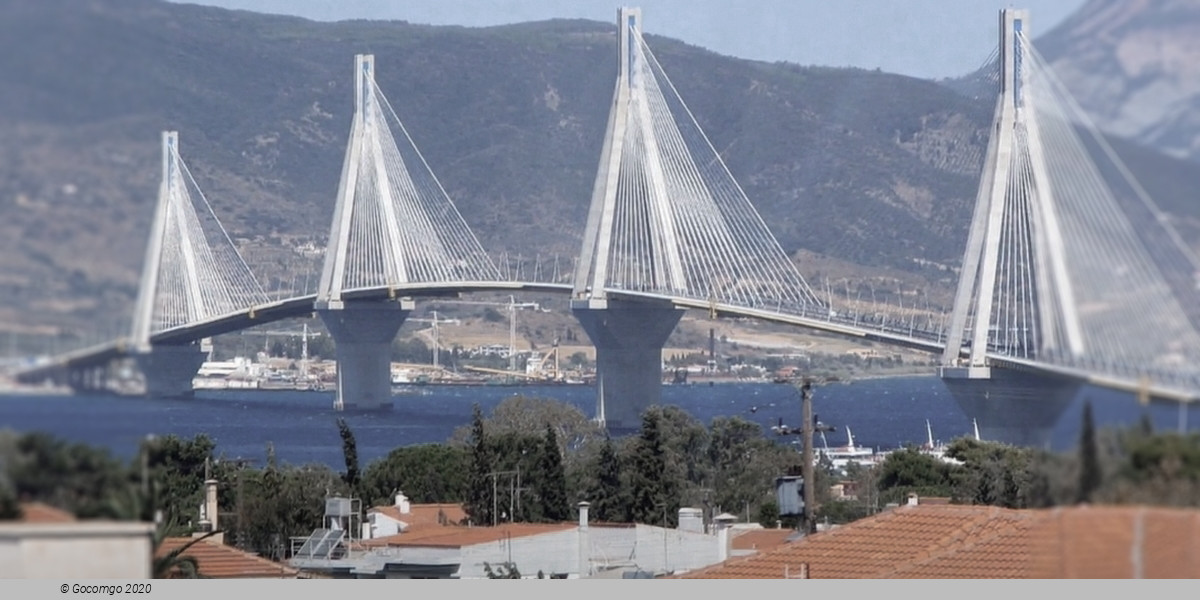Patras

Patras is Greece's third-largest city and the regional capital of Western Greece, in the northern Peloponnese, 215 km (134 mi) west of Athens. The city is built at the foot of Mount Panachaikon, overlooking the Gulf of Patras.
Antiquity
The first traces of settlement in Patras date to as early as the third millennium BC, in the area of modern Aroi. Patras flourished for the first time in the Post-Helladic or Mycenean period (1580–1100 BC). Ancient Patras was formed by the unification of three Mycenaean villages in modern Aroi, namely ancient Aroe, Antheia (from mythological Antheia) and Mesatis. Mythology has it that after the Dorian invasion, a group of Achaeans from Laconia led by the eponymous Patreus established a colony. In antiquity Patras remained a farming city. It was in Roman times that it became an important port.
After 280 BC and prior to the Roman occupation of Greece, Patras played a significant role in the foundation of the second "Achaean League" (Achaiki Sympoliteia), along with the cities of Dyme, Tritaea and Pharai. Later on, and following the Roman occupation of Greece in 146 BC, Patras played a key role, and Augustus refounded the city as a Roman colony in the area. In addition, Patras has been a Christian centre since the early days of Christianity, and it is the city where Saint Andrew was crucified.
Middle Ages and early modern
In the Byzantine era Patras continued to be an important port as well as an industrial centre. One of the most scholarly philosophers and theologians of the time, Arethas of Caesarea was born at Patrae, at around 860. By the 9th century, there are strong signs the city was prosperous: the widow Danielis from Patras had accumulated immense wealth in land ownership, the carpet and textile industry, and offered critical support in the ascent of Basil I the Macedonian to the Byzantine throne.
In 1205 the city was captured by William of Champlitte and Villehardouin, and became a part of the principality of Achaea. It became the seat of the Barony of Patras, and its Latin archbishop primate of the principality. In 1408, Patras became Venetian, until it was recaptured in 1430 by the Despotate of Morea and its despot Constantine Palaiologos, who thus succeeded in recovering for the Byzantine Empire the whole of the Morea, apart from Venetian possessions. The administration of Patras was given to George Sphrantzes, while Constantine was immediately contested by the Ottoman Empire and later, in 1449, became emperor of the Byzantine empire.
Patras remained a part of the Despotate of Morea until 1458, when it was conquered by the Sultan of the Ottoman Empire, Mehmet II. Under the Ottomans, it was known as "Baliabadra", from the Greek: Παλαιά Πάτρα ('Old Patras'), as opposed to Νέα Πάτρα ('new Patra'), the town of Ypati in Central Greece. Though Mehmet granted the city special privileges and tax reductions, it never became a major centre of commerce. Venice and Genoa attacked and captured it several times in the 15th and 16th centuries, but never re-established their rule effectively, except for a period of Venetian rule in 1687–1715 after the Morean War.
In 1772 a naval battle took place off the city between the Russians and Ottomans.
Modern era
Patras was one of the first cities in which the Greek Revolution began in 1821; the Ottoman garrison, confined to the citadel, held out until 1828. Finally the city was surrendered on 7 October 1828 to the French expeditionary force in the Peloponnese, under the command of General Maison. After the war, most of the city and its buildings were completely destroyed. The new city was planned under the supervision of Stamatis Voulgaris following orders by Ioannis Kapodistrias.
Patras developed quickly into the second-largest urban centre in late-19th-century Greece. The city benefited from its role as the main export port for the agricultural produce of the Peloponnese.
In the early 20th century, Patras developed fast and became the first Greek city to introduce public streetlights and electrified tramways. The war effort necessitated by the First World War hampered the city's development and also created uncontrollable urban sprawl after the influx of displaced persons from Asia Minor after the 1922 population exchange between Greece and Turkey. In the Second World War the city was a major target of Italian air raids. In the Axis occupation period, a German military command was established and German and Italian troops stationed in the city. After the liberation in 1944, the city recovered, but in later years was increasingly overshadowed by the urban pole of Athens. Since 2014, mayor of the city is Kostas Peletidis.

